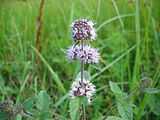Mentha aquatica
| Mentha aquatica | |
|---|---|
 | |
| Plant in flower | |
| Scientific classification | |
| Kingdom: | Plantae |
| (unranked): | Angiosperms |
| (unranked): | Eudicots |
| (unranked): | Asterids |
| Order: | Lamiales |
| Family: | Lamiaceae |
| Genus: | Mentha |
| Species: | M. aquatica |
| Binomial name | |
| Mentha aquatica L. | |
| Synonyms[1] | |
|
List
| |
Mentha aquatica (water mint; syn. Mentha hirsuta Huds.[2]) is a perennial plant in the genus Mentha, that grows in damp places and is native to much of Europe, northwest Africa and southwest Asia.[2][3]
Description
Water mint is a herbaceous rhizomatous perennial plant growing to 90 centimetres (35 in) tall. The stems are square in cross section, green or purple, and variably hairy to almost hairless. The rhizomes are wide-spreading, fleshy, and bear fibrous roots. The leaves are ovate to ovate-lanceolate, 2 to 6 centimetres (0.79 to 2.36 in) long and 1 to 4 centimetres (0.39 to 1.57 in) broad, green (sometimes purplish), opposite, toothed, and vary from hairy to nearly hairless. The flowers of the watermint are tiny, densely crowded, purple, tubular, pinkish to lilac in colour and form a terminal hemispherical inflorescence; flowering is from mid to late summer. Water mint is pollinated by insects, and also spreads by underground rhizomes, like other species of mint. All parts of the plant have a distinctly minty smell.[3][4][5] A variety known as Mentha aquatica var. litoralis is native to areas of Sweden and Finland near the Baltic Sea. It is unbranched, hairless, with narrower leaves and paler flowers.[6]
Distribution and habitat
Water mint is native to much of Europe, northern Africa and western Asia. It has been introduced to North and South America, Australia and some Atlantic islands.[6]
As the name suggests, water mint occurs in the shallow margins and channels of streams, rivers, pools, dikes, ditches, canals, wet meadows, marshes and fens. If the plant grows in the water itself, it rises above the surface of the water. It generally occurs on mildly acidic to calcareous (it is common on soft limestone) mineral or peaty soils.[3][4] M. aquatica can occur in certain fen-meadow habitats such as the Juncus subnodulosus-Cirsium palustre plant association.[7] It is a component of Purple moor grass and rush pastures - a type of Biodiversity ActPlan habitat in the UK. It is also found in a pond in Castlehead, Cumbria ; Lake District lol.
It hybridises with Mentha spicata (spearmint) to produce Mentha × piperita (peppermint), a sterile hybrid; with Mentha suaveolens (apple mint) to produce Mentha × suavis; with Mentha arvensis (corn mint) to produce Mentha × verticillata; and with both M. arvensis and M. spicata to give the tri-species hybrid Mentha × smithiana.[3] It can be used to make a herbal tea.[6]
Image gallery
-
_-_uitsnede.jpg)
corolla mauve, leaves opposite [1]
-

-

- ^ Rose, Francis (1981). The Wild Flower Key. Frederick Warne & Co. p. 310. ISBN 0-7232-2419-6.
References
| Wikimedia Commons has media related to Mentha aquatica. |
- ↑ "The Plant List: A Working List of All Plant Species". Retrieved April 3, 2014.
- ↑ 2.0 2.1 Euro+Med Plantbase Project: Mentha aquatica
- ↑ 3.0 3.1 3.2 3.3 Flora of NW Europe: Mentha aquatica
- ↑ 4.0 4.1 Blamey, M. & Grey-Wilson, C. (1989). Flora of Britain and Northern Europe. ISBN 0-340-40170-2
- ↑ Huxley, A., ed. (1992). New RHS Dictionary of Gardening. Macmillan ISBN 0-333-47494-5.
- ↑ 6.0 6.1 6.2 "Water mint: Mentha aquatica". NatureGate. Retrieved 2013-12-13.
- ↑ C. Michael Hogan. 2009. Marsh Thistle: Cirsium palustre, GlobalTwitcher.com, ed. N. Strömberg